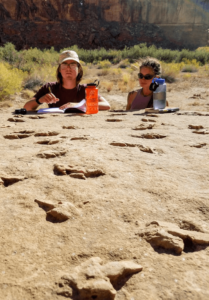
The morning is cool but not cold. Spared from the wind, I easily boil a pot of water to wake my comrades with. Everyone is asleep under the vast desert sky, their snores echoing off the walls of the three shallow canyons just beyond camp. Though the urgent need for coffee usually rouses them in good time, long days wading through the Dirty Devil River and bushwhacking through snarling tamarisks have prompted longer sleeps and slower mornings.
It’s nearly seven o’clock. The sun has slowly crept above the rim of the canyon. A touch of pink bleeds from the horizon, threatening to explode into a grand show of color and vibrancy. I study journalism, and we are often instructed to avoid clichés—sunsets being just that. I forego this rule for the simple justification that a desert sunset is unlike any other, especially when witnessed from the bottom of a canyon.
The star of the morning’s performance are the walls: Rising hundreds of feet above the canyon floor, their omnipresence inspires both security and humility. We’ve been afforded the opportunity to become intimately acquainted with these formations through extended occupation as well as geological study.
As we attempt to wade through the timeline of these ancient layers, it becomes challenging to conceptualize the reality of such deep time. The Navajo Sandstone, one of the youngest layers we’ve encountered, is roughly 135 to 190 million years old. This fluid and sweeping sedimentary layer, a mere yearling in the grand scope of time, keeps secrets of a world we as humans never knew. As a group of self-proclaimed story tellers, naturalists, geologists and admirers, we attempt to piece together the puzzle through hints offered by the landscape—high water lines, petrified wood, old river beds, pictographs. But even so, we are left with only partial narratives and great room for imagination.
Perhaps the most generous, though, of these windows into history are footprints; impressions left in the sand by a prehistoric dweller, now cemented in fallen rocks and overhanging roofs. We put our hands over the top of the three-pronged tracks of the Grallator, feeling the weight of its presence-that-was. I glimpse with closed eyes into an alternate image of the ground we stand on inhabited by beings we’ll never truly see.
The knowledge of this past world overwhelms me, but the rocks remain still, humbly storing the incomplete narrative of what we now call the Colorado Plateau. What role do we as humans play in this ongoing story? Thus far, we are but a speck on the scale of time, but it seems as though our ostentatious exit has begun. In class, we entertain the question of human permanence. We debate the author David Quamman and his conclusion that we are approaching the sixth great mass extinction. Looking at a more hopeful prophecy, some predict that we are merely building up to an inevitable breakdown which we will survive on the margins and bounce back to the beginning to start anew.
As young people seeking to identify our roles in this world with threats like climate change looming over us, in fact not raining on our parade of youth but rather drying it up, we are embattled with these existential ponderings. To explore them in the wise canyons of the Colorado Plateau with other curious minds is a privilege, and I emerge from each conversation a bit more encouraged that perhaps through our collective advocacy we can begin to dim the ever-brightening light of defeat.
The sun’s ascent has hastened in pace, and the cliff walls are now illuminated with the royal golden light reserved for the resilient guardians of the desert. They protect the secrets of what was, but do they know the secrets of what will be? Will we persist and learn to exist in harmony with this fragile world, or are we fated to remain only as petrified footprints in the sand? I so badly want to ask, but I know these ways of knowing must be earned. I whisper a thank you before waking my peers to another glorious day in desert country. Today we will travel onward down river, paying close attention to the walls and seeking a bit more truth with each gained mile, learning to embrace the mystery of what lies ahead.